Last September when I went on a solo trip to Iceland, a well-deserved mommy-break I got to see many wonders of Nature, very unique and which you can find in very few places like Iceland. Here is my experience of Natural Wonders I found on the Golden Circle route, the most famous tourist route in Iceland!
I combined golden circle trip with ‘delicious farm to table food trail’ and ‘volcanic lava tube caving‘ along with relaxing soak in ‘hot springs of Fontana spa‘ with Icelandic Mountain Guides, the best tour operator in Iceland from my experience. My trip was more of a private kind of tour where I had the company of a lovely young couple and a knowledgeable guide with Stefan Pall.
THINGVELLIR NATIONAL PARK
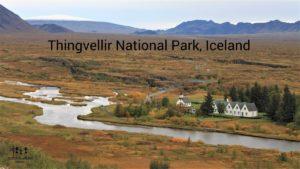
As you approach Thingvellir national park also known as Þingvellir, you start noticing lakes and islands in those lakes looking like small hills in the middle of lakes, those are actually craters of the volcano. You can’t fail to see smoke rising in some parts of the landscape if you look anywhere. At Part of Thingvellir national park, was originally Birch woodland, but the lack of woodland is a striking feature of not just Thingvellir but the whole of Iceland. This entirely volcanic island has lava fields and a volcanic eruption is regular here too so it’s hard for tall trees to thrive on this volcanic land here. Therefore all you can see is a cover of vegetation and not woods. Our guide Stefan told us Icelandic people’s insider joke about Icelandic woods, ” If you get lost in Icelandic woods, all you need to do is stand up!”
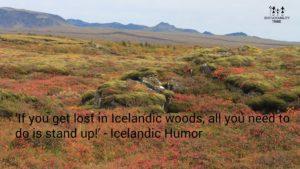
Icelandic Woods
In September I was lucky to see colorful vegetation cover all over Iceland, the autumn colors made it even more beautiful.
1. OPEN AIR PARLIAMENT
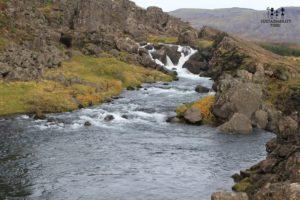
Öxará River
It’s interesting to see some sketches of this assembly on information boards here. River Öxará flows through Thingvellir national park not too far from Assembly site. The Assembly even used to punish criminals or witches in the nearby drowning pool on Oxara river.
2. TECTONIC PLATES (BETWEEN EUROPE AND AMERICA)
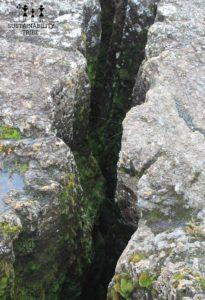
The Þingvellir area is part of a fissure zone running through Iceland, being situated on the tectonic plate boundaries of the Mid-Atlantic Ridge. So here you can be in between two tectonic plates Eurasia and North America. How cool is that isn’t it? I was particularly very excited about this ‘walk between the two continents’, which I read online while reading through Iceland Travel material. But our guide clarified that there is no such specific place where you can walk between two continents, as not just Thingvellir National park but whole Iceland is part of North Atlantic ridge and formed because of rifting of these two tectonic plates.
The Almannagjá fault is a great example of this rifting of tectonic plates. This is a pathway which leads to open air parliament from information center uphill. Till 2011 it used to be a gravel path but in 2011 this crack opened with just a small hole on surface and rocks beneath it. Historically there used to be a temporary market and homes on this pathway during annual assembly. The hills on both sides used to give protection from elements. But now you can walk here between North America and Europe on a wooden pathway built on Almannagjá ravine.
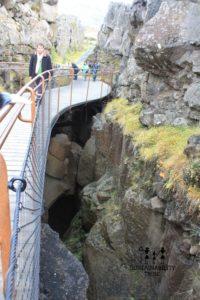
Almannagjá fault
If you are visiting here, please spare some time and read all those information boards, more you get to know about these natural wonders, more fascinated you get about Iceland. While I was reading one such information board, there was a preschooler almost same age of my son, running continuously from here to there and his mom was unable to focus though she was really interested in reading. I could completely relate to that situation and couldn’t resist talking to her. I told her how I am on a mommy-me time solo trip while my hubby is taking care of my son back home and how my son would have done an exact same thing if he would have been here. She obviously said I am lucky and even brave. Though I was living the dream of any mom, traveling on my own, doing things which I like while on travel, moments like these when I saw families with kids I wished my boys are with me.
3. SILFRA FISSURE AT LAKE THINGVELLIR
Thingvellir lake or Þingvallavatn is the largest natural lake in Iceland and is a rift valley lake. Lake Thingvellir is also a popular spot for research on evolution and formation of new species.
Three of the five species of freshwater fish found in Iceland live in Lake Þingvallavatn; those are brown trout, Arctic charr, and the three-spined stickleback. These fish became isolated in the lake in the wake of the last ice age when the terrain rose at the south end of Þingvallavatn. The existence of 4 separate variety or morphs of arctic char (fish) is a great example of how species evolve and adapt to their surroundings.
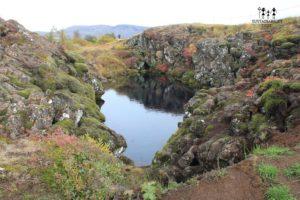
Silfra
One of the interesting features of Lake Thingvellir is Silfra fresh water fissure situated northern side of the lake and is popular for scuba diving or snorkeling. Rather it is the only place on the earth where you can dive between two tectonic plates or continents. Our guide took us to the spot from where divers jump in the waters of Silfra fissure. I even touched the water and it was ice cold, I wondered how those adventure junkies were diving in that coldness. But a diving instructor told me that they are covered completely, up to the wrist, only palms are not covered. Water in Silfra is clearest waters in the world, the underwater visibility here is over 100 meters, so obviously diving here must be an experience to remember for the lifetime. We could see so much deeper in the water just from the bank of Sifra, really never seen such clear water!
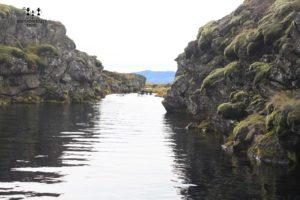
Along with the Thingvellir valley, Silfra is formed by the divergent tectonic drift of the Eurasian and North American plates. The plates drift about 2 cm farther apart every year.
STROKKUR GEYSER OF HAUKADALUR GEOTHERMAL AREA
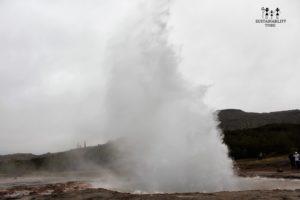
Strokkur Geysir
What if I tell you the word geyser has come from Iceland? Go on Wikipedia and it will tell you the real story how the word geyser came from famous Geysir of Haukadalur, Iceland. The name Geysir itself is derived from the Icelandic verb geysa, “to gush”. The great Geysir used to erupt till 1916. Later many artificial efforts were taken to aid the eruption of Geysir like digging a channel around the edge of geyser vent or adding soap. In 2000, an earthquake revived the geyser again and it reached 122 meters for two days, thus becoming one of the highest known geysers in history. Now it erupts rarely.
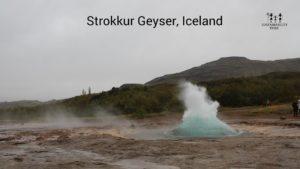
But the nearby Strokkur geyser erupts much more frequently and now is popular among tourists. I was really lucky to see one double eruption and one eruption of Strokkur. Watch this video of Strokkur’s double eruption.
There are some smaller geysers in this area like Litli geyser. I even touched the runoff water of Strokkur geyser at a far distance from the geyser and it was still hot on a stormy cold day. I would say this is one the most exciting experience in the Golden circle, you need to wait for around 10 minutes and then it erupts with great force! Once the water is gushed out the new water from inside the geyser boils, the resulting pressure forces a superheated column of steam and water to the surface through the geyser’s internal plumbing and it erupts again. Due to geysers in Haukadalur Geothermal Area, this valley is popular among tourists since the 18th century.
GULLFOSS
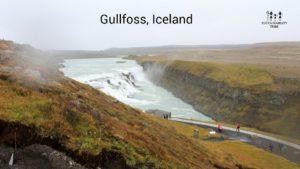
Also known as Golden Foss (waterfall) is located on the canyon of the Hvítá river and is the national symbol of unity. The waterfall is divided into two stages and then the river turns sharply to the left into a narrow and steep canyon. On a clear day, you can see rainbows over this powerful waterfall, but we were not as lucky. The day of our golden circle tour was stormy, rainy, windy and overcast. Frankly, my Gullfoss memories are mainly memories of feeling very cold and walking against strong cold winds! It is recommended to walk along the whole route, the route is wheelchair friendly and lasts about half an hour walk and you can see the falls from different angles. But we couldn’t walk all the way all thanks to strong chilly winds. But the views of Gullfoss are amazing from the top near Tourist information, I am sure it can get overpowering to see such huge waterfall from close. There are so many other beautiful and graceful waterfalls in Iceland but this one stands out for its ruggedness and strength.
By now I don’t have to tell you that Golden circle route and natural wonders on this route are not to be missed when in Iceland. You can either drive on your own or take a tour, I personally highly recommend Icelandic Mountain Guides.
Also highly recommend this unique guide ‘Sustainable Travel to Iceland‘, don’t forget to download the free guide which will come handy during your travel.


